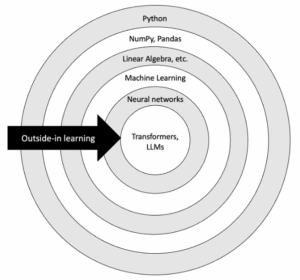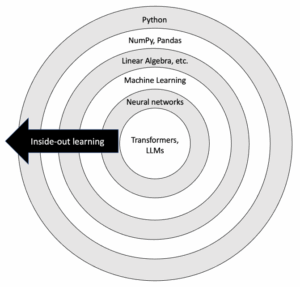For more than a year, I have been wanting to learn AI and how LLMs work.
But no matter how much I tried, nothing seemed to work. I would keep starting and stopping. But one day, I took a totally new approach, and within a few days, everything started making sense.
Here is my journey and a learning I want to share with you.
Whenever I would think of learning AI, I would search online for a learning path. And inevitably, the advice would be somewhat as follows: First learn Python. Then NumPy and pandas. Then statistics, linear algebra, and calculus. Then do a course on machine learning, followed by neural networks. Then finally do transformers and LLMs.
Sounds logical. Also sounds like a multi-year PhD track.
Let us visualize these series of topics as concentric circles, where you master the topic in the outside ring before learning the topic in the inner ring (see image below). This is our normal approach to learning, and let us call this ‘Outside-in’ learning.
I tried this ‘outside-in’ approach. Multiple times. But it didn’t work. The problem was that mastering any of the topics takes immense time and motivation. And all this while, the final goal of understanding LLMs felt so far away that I wasn’t sure I was doing the right thing.
Also, honestly, this was just a hobby for me and I could only give it so much time. So I would put in some effort but give up after some time. And since I have so much regular work while running HabitStrong, that I was ready to give up on learning AI until my friend Vinod gave me a pause.
He said, “Don’t bother with all that. Much of the stuff that you need to know, you have studied it in some shape or form even if you don’t remember it fully.
“So instead of trying to go linearly, let us start from the end point. Go straight to transformers. Fill the gaps only when you get stuck.” Let us call this the “Inside-out” approach to learning (see below).
And that’s what I did.
One Saturday, I dedicated the whole day to AI and sat down with my friend Vinod. I put aside everything else and went through a YouTube playlist Vinod shared with me. We discussed and clarified my doubts. And in a day and a half, I understood how transformers and LLMs work. Not at an implementation level, but at least conceptually.
That was the breakthrough. Now I was motivated because things started to make sense – LLMs were no longer a black box.
Sure, I couldn’t write the PyTorch code for it yet, but I had gone from zero to meaningful understanding in less than two days. But if I had taken the traditional linear approach, I’d have quit before even completing step 1. The journey would’ve just felt too long and demotivating.
Instead, this new approach…start at the center, then zigzag outward…felt energizing.
And here’s why it works:
- You don’t need to master every prerequisite in sequence.
- You often know more than you think – you just need to refresh your memory.
- When there are must-fill knowledge gaps, you quickly learn enough to be able to move forward instead of mastering a whole new subject.
- When you start at the core, the sense of progress is immediate. It spikes your motivation.
- When you want to backfill the learning gaps, LLMs (e.g., chatGPT, Claude) can help you do it on demand, in real time. (The irony of using LLMs to learn LLMs. 😁)
In school, we were taught that learning is a staircase. First you do X, then Y, then Z. But in the real world, it’s a zigzag. You touch the surface, go deeper, loop back, fill gaps, and jump forward again.
Now, just to be clear: If you have zero pre-requisite knowledge, then this approach won’t work. But more often than not, we do have a smattering of understanding of many of the pre-requisites.
So if you’re trying to learn something complex, whether it’s AI, finance, or filmmaking, don’t wait until you exhaustively “cover the basics.” You’ll probably quit.
Instead, start with something real. Something that excites you. Something you want to understand today. When you hit a wall, pause and learn what’s needed to get over that wall.
That is the secret to learning difficult things, super-fast, in the midst of a busy work life. This is not a shortcut, but just a smart way to learn.
And most importantly, when you do it this way, you see progress, feel motivated, and stay in the learning game long enough to actually hit the finish line.
Rajan
P.S. I have not been writing because I was on a vacation. Here are some photos. 😊




